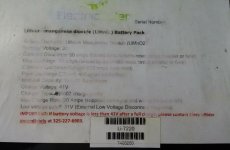joeuser999
100 µW
- Joined
- Jul 11, 2019
- Messages
- 8
I have a pair of 20ah 36v LiMn batteries that were originally built by electricrider.com in 2012 for a 72v/40a crystalite system. I believe they are sanyo cells..
I went for a ride the other day and they performed well. I did not immedeatly charge when i got home.. today i went to hook up my chargers and got nothing.
Volt meter reports 0volts on battery A and battery B was at ~16v, then that voltage rapidly began to fall within a few seconds of the volt meter being connected.
Not sure how many total charge cycles i have on them but I commuted ~30 miles every summer day for 2-3 years & since that time, just a few rides here and there, so maybe a few hundred cycles. They've been working well for the past several months and are now completely drained & not taking a charge.
Are these batteries toast? is there hope to revive them?
If yes, what is my best course of action for success?
if no, can anyone recommend a viable replacement with similar performance?
Thanks in advance
I went for a ride the other day and they performed well. I did not immedeatly charge when i got home.. today i went to hook up my chargers and got nothing.
Volt meter reports 0volts on battery A and battery B was at ~16v, then that voltage rapidly began to fall within a few seconds of the volt meter being connected.
Not sure how many total charge cycles i have on them but I commuted ~30 miles every summer day for 2-3 years & since that time, just a few rides here and there, so maybe a few hundred cycles. They've been working well for the past several months and are now completely drained & not taking a charge.
Are these batteries toast? is there hope to revive them?
If yes, what is my best course of action for success?
if no, can anyone recommend a viable replacement with similar performance?
Thanks in advance


